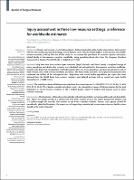| dc.contributor.author | Gupta, Shailvi | |
| dc.contributor.author | Wren, Sherry M | |
| dc.contributor.author | Kamara, Thaim B | |
| dc.contributor.author | Shrestha, Sunil | |
| dc.contributor.author | Kyamanywa, Patrick | |
| dc.contributor.author | Wong, Evan G | |
| dc.contributor.author | Groen, Reinou S | |
| dc.contributor.author | Nwomeh, Benedict C | |
| dc.contributor.author | Kushner, Adam L | |
| dc.contributor.author | Price, Raymond R | |
| dc.date.accessioned | 2022-04-11T12:19:09Z | |
| dc.date.available | 2022-04-11T12:19:09Z | |
| dc.date.issued | 2015 | |
| dc.identifier.citation | Gupta, S., Wren, S.M., Kamara, T.B., Shrestha, S., Kyamanywa, P., Wong, E.G., Groen, R.S., Nwomeh, B.C., Kushner, A.L. and Price, R.R. (2015). Injury assessment in three low-resource settings: a reference for worldwide estimates. The Lancet, 385, p.S2. | en_US |
| dc.identifier.issn | 0140-6736 / 1474-547X | |
| dc.identifier.uri | http://hdl.handle.net/20.500.12280/2940 | |
| dc.description.abstract | Background
Trauma has become a worldwide pandemic. Without dedicated public health interventions, fatal injuries will rise 40% and become the 4th leading cause of death by 2030, with the burden highest in low-income and middle-income countries (LMICs). The aim of this study was to estimate the prevalence of traumatic injuries and injury-related deaths in low-resource countries worldwide, using population-based data from the Surgeons OverSeas Assessment of Surgical Need (SOSAS), a validated survey tool.
Methods
Using data from three resource-poor countries (Nepal, Rwanda, and Sierra Leone), a weighted average of injury prevalence and deaths due to injury was calculated and extrapolated to low-resource countries worldwide. Injuries were defined as wounds from road traffic injuries (bus, car, truck, pedestrian, and bicycle), gunshot or stab or slash wounds, falls, work or home incidents, and burns. The Nepal study included a visual physical examination that confirmed the validity of the self-reported data. Population and annual health expenditure per capita data were obtained from the World Bank. Low-resource countries were defined as those with an annual per capita health expenditure of US$100 or less.
Findings
The overall prevalence of lifetime injury for these three countries was 18·03% (95% CI 18·02–18·04); 11·64% (95% CI 11·53–11·75) of deaths annually were due to injury. An estimated prevalence of lifetime injuries for the total population in 48 low-resource countries is 465·7 million people; about 2·6 million fatal injuries occur in these countries annually.
Interpretation
The limitations of this observational study with self-reported data include possible recall and desirability bias. About 466 million people at a community level (18%) sustain at least one injury during their lifetime and 2·6 million people die annually from trauma in the world's poorest countries. Trauma care capacity should be considered a global health priority; the importance of integrating a coordinated trauma system into any health system should not be underestimated. | en_US |
| dc.language.iso | en | en_US |
| dc.publisher | Elsevier Science Inc , Ste 800, 230 Park Ave, New York, Usa, Ny, 10169 | en_US |
| dc.relation.ispartofseries | The Lancet;385 | |
| dc.subject | Injury assessment | en_US |
| dc.subject | Low-resource settings | en_US |
| dc.subject | Estimates | en_US |
| dc.title | Injury Assessment in Three Low-resource Settings: A Reference for Worldwide Estimates | en_US |
| dc.type | Article | en_US |


